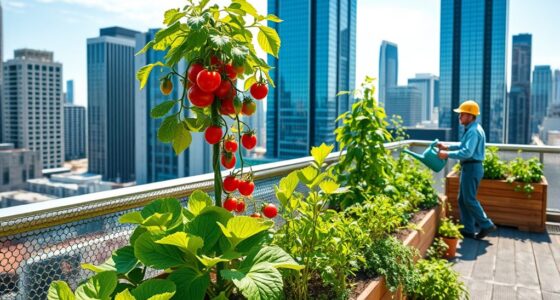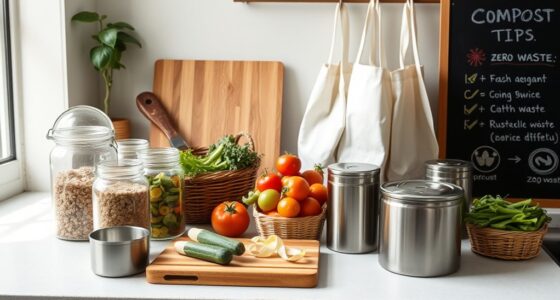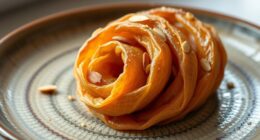Understanding how extraction time and temperature influence your cold brew is key to achieving your desired flavor. Longer steeping (like 12-24 hours) at colder temperatures results in a smoother, well-rounded coffee, while warmer water speeds up extraction and brings out brighter, more aromatic notes. Too long or high temperature can cause bitterness, so finding the right balance is essential. Keep exploring to discover how adjusting these factors creates your perfect cold brew.
Key Takeaways
- Longer steeping times (12-24 hours) at cold temperatures extract richer flavors but can lead to bitterness if overextended.
- Higher brewing temperatures increase solute solubility, resulting in more complex and aromatic cold brew profiles.
- Cooler extraction temperatures favor smoother, less acidic flavors, while warmer temps enhance brightness and intensity.
- Precise control of time and temperature allows for fine-tuning flavor, aroma, and strength of the cold brew.
- Monitoring and tasting during brewing helps optimize extraction, balancing brightness, smoothness, and strength.
The Basics of Cold Brew Extraction
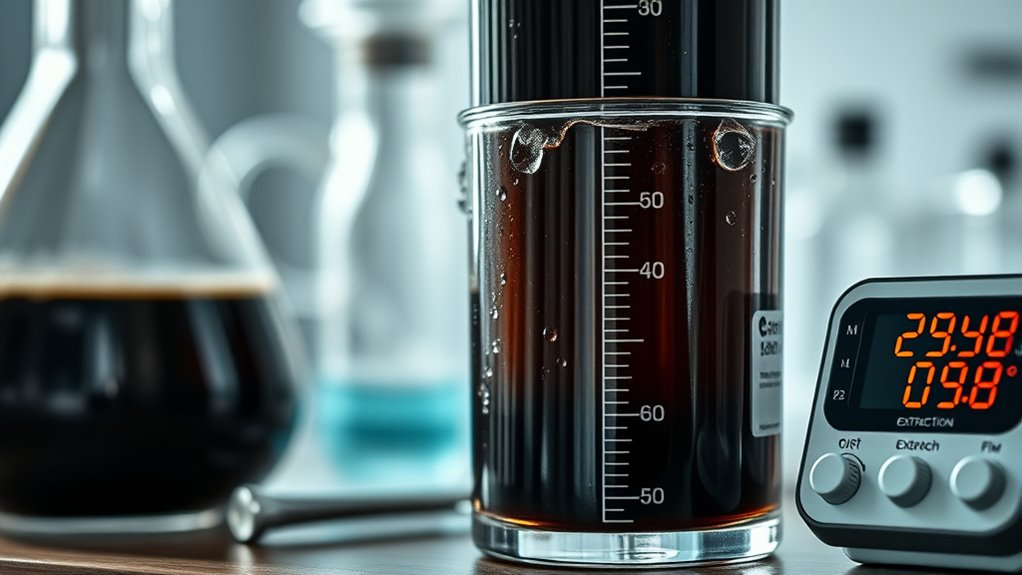
Cold brew extraction involves steeping coarsely ground coffee in cold water for an extended period, typically 12 to 24 hours. During this time, the coffee grounds gradually release their flavors, oils, and dissolved solids into the water. Using the right grind size is crucial because it influences the extraction rate and overall flavor profile. Unlike hot brewing methods, cold extraction relies on a slow, steady process that prevents over-extraction and bitterness. You’ll want to use a coarse grind to maximize surface area and guarantee even extraction. As the steeping continues, the coffee’s compounds dissolve into the water, producing a smooth, concentrated brew. It’s important to maintain consistent contact between water and coffee grounds, which is why steeping time is vital. The longer you steep, the more intense and full-bodied your cold brew will become. Additionally, understanding the role of attention in the process can help optimize your brewing technique for better flavor extraction, especially considering the lifestyle benefits of cold brew consumption. Maintaining proper temperature control can further enhance extraction efficiency and flavor clarity throughout the process.
How Temperature Influences Coffee Solubility
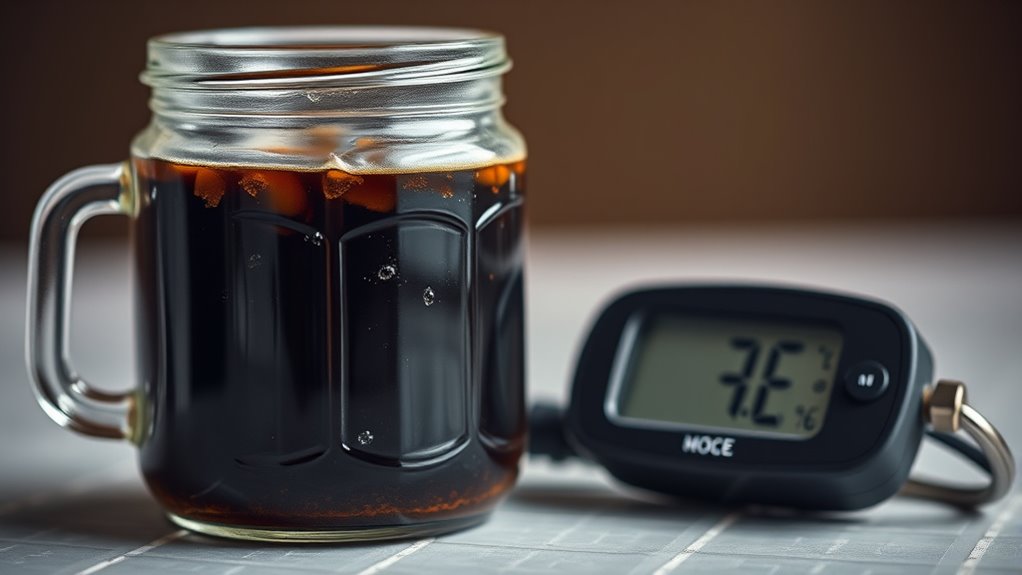
Temperature plays a significant role in how coffee compounds dissolve into water. As temperature increases, more solutes, like caffeine and aromatic oils, become soluble, making your cold brew more flavorful and robust. Warmer water speeds up molecular movement, allowing extraction of desirable flavors more quickly. Conversely, colder water extracts fewer compounds, resulting in a smoother, milder taste. However, if the water is too cold, some solutes may not fully dissolve, leading to a less balanced brew. Understanding this balance helps you control the strength and character of your cold brew. Additionally, utilizing extraction efficiency techniques can help you better evaluate the visual quality of your brew. Adjusting temperature allows you to fine-tune extraction, achieving your preferred flavor profile. So, whether you’re brewing in the fridge or at room temperature, temperature directly influences how much of each compound ends up in your final cup. Recognizing how temperature impacts solubility can further refine your brewing process for optimal results. Knowing how different brewing temperatures affect ground size and contact time can further optimize your extraction process for ideal flavor, especially since water temperature also impacts how effectively soluble compounds are released.
The Role of Extraction Time in Flavor Development
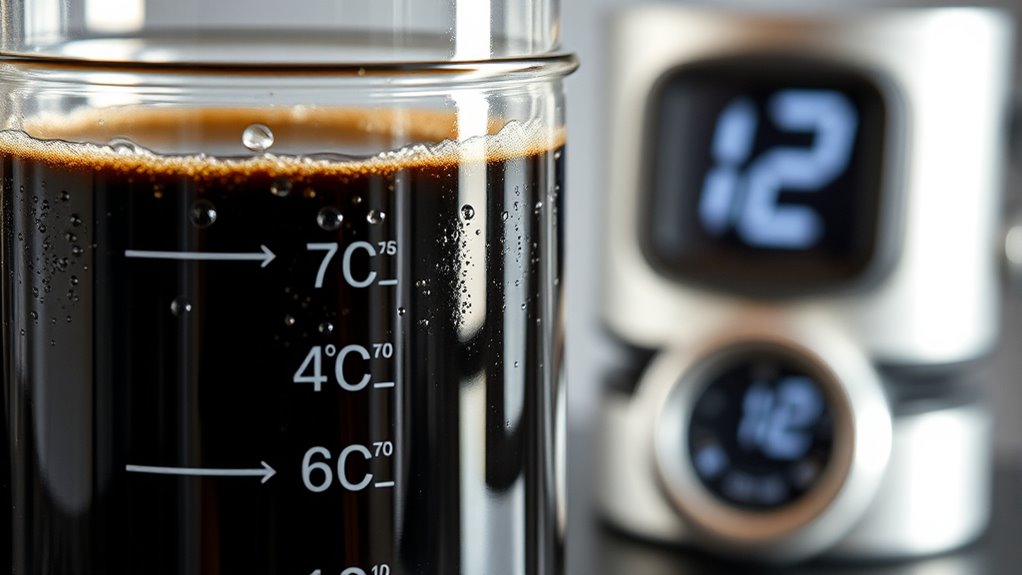
Extraction time directly affects the complexity and balance of your cold brew’s flavor. If you steep it too briefly, you’ll miss out on developing rich, nuanced notes, resulting in a weak, underwhelming drink. On the other hand, letting it steep too long can lead to over-extraction, creating bitterness and astringency. Finding the right balance is key; typically, 12 to 24 hours works well for most brews. During this period, the flavors and aromatics are gradually released from the coffee grounds. Longer extraction increases sweetness and body, while shorter times preserve brighter, more delicate flavors. Adjusting steeping time allows you to tailor your cold brew to your taste preferences, whether you prefer a smooth, mellow profile or a bold, intense one. Selecting the appropriate extraction method is essential for achieving the desired flavor profile.
Comparing Cold Brew at Different Temperatures
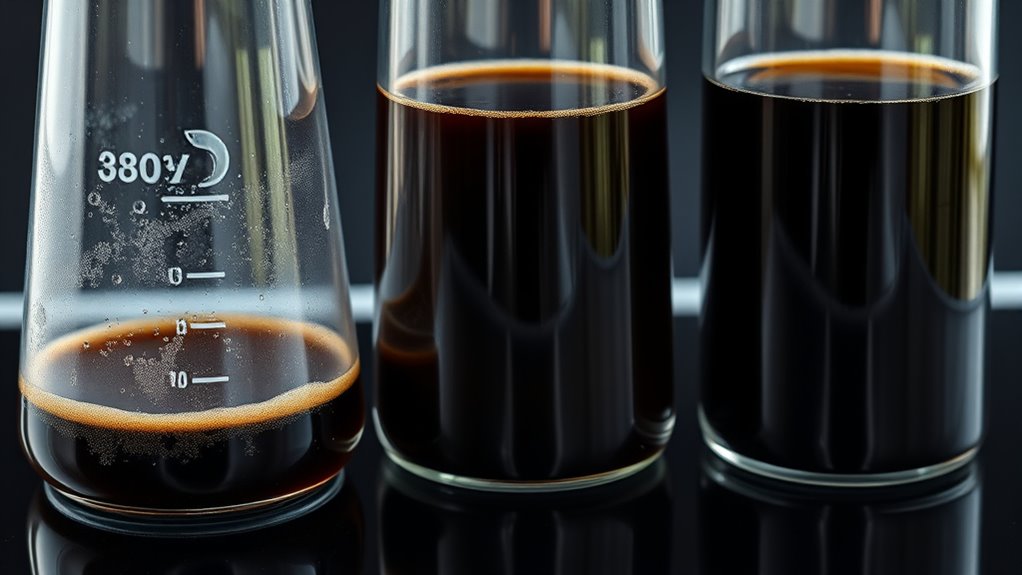
When you compare cold brews made at different temperatures, you’ll notice changes in flavor extraction and aroma. Lower temperatures often produce a smoother, less bitter profile, while higher temperatures can enhance certain aromatic notes. Understanding these differences helps you tailor your brew to match your preferred taste and aroma. Additionally, controlling the extraction process through temperature adjustments can optimize the overall quality and complexity of your cold brew. Variations in temperature can also influence the rate of extraction, affecting how quickly flavors develop during brewing. Recognizing how temperature impacts flavor profile allows brewers to experiment with different methods to achieve their ideal cold brew. Monitoring brewing conditions such as temperature and time enables more precise control over the desired flavor outcome and consistency.
Flavor Extraction Variations
As you explore different cold brew methods, you’ll notice that brewing at varying temperatures considerably influences the flavor profile. When you brew at lower temperatures, the result tends to be smoother and less acidic, highlighting sweet and chocolatey notes. Higher temperatures, on the other hand, extract more complex flavors, including brighter fruit and floral tones, but can also increase bitterness. Cold brews made at colder temperatures often have a calmer, more mellow taste, while warmer extractions deliver a bolder and more vibrant cup. The temperature you choose impacts not only flavor intensity but also how certain compounds, like acids and oils, are extracted. By adjusting temperature, you can fine-tune your cold brew to match your preferred flavor profile.
Brew Time Differences
Brew time plays a crucial role in shaping the flavor of your cold brew, especially when comparing different temperatures. When you brew at colder temperatures, you’ll notice that longer extraction times are necessary to fully develop flavors. A shorter brew at a higher temperature may produce a brighter, more vibrant profile, while extended steeping at lower temperatures results in a smoother, more mellow drink. If you keep the brewing time consistent across different temperatures, the flavor profile shifts profoundly. For example, a cold brew steeped for 12 hours at 40°F will taste different from one brewed for the same duration at 60°F. Adjusting brew time based on temperature allows you to fine-tune the balance between brightness, body, and smoothness in your cold brew. Additionally, understanding how extraction time influences flavor can help you create a more precise and satisfying cold brew experience.
Aromatic Profile Shifts
Temperature profoundly influences the aromatic profile of your cold brew. When you brew at lower temperatures, expect subtle, delicate aromas with floral and fruity notes that highlight freshness. As you increase the temperature, these aromas become more pronounced and complex, revealing richer, roasted, and chocolatey scents. Higher temperatures also accelerate extraction, bringing out deeper aromatic compounds faster. Cooler brewing temperatures help preserve volatile aroma compounds, resulting in a lighter, more nuanced scent profile. Additionally, brewing temperature plays a crucial role in determining the overall flavor balance and extraction efficiency. Proper temperature control can optimize aroma preservation, allowing for a tailored sensory experience. Controlling extraction time alongside temperature allows for more precise manipulation of aroma and flavor development. Understanding the relationship between temperature and chemical reactions during extraction can further enhance your brewing control.
Optimal Extraction Durations for Flavor Clarity

Finding the right extraction duration is crucial for achieving flavor clarity in cold brew. Generally, a steep time of 12 to 24 hours strikes the best balance, allowing your coffee’s bright, nuanced notes to shine without becoming muddled. Shorter times, around 8 hours, may produce a lighter, less intense brew, emphasizing delicate flavors. Conversely, extending beyond 24 hours risks over-extraction, which can introduce bitterness and a dull taste. To optimize clarity, monitor your brew’s progress and adjust based on your preference. Using a consistent grind size and proper agitation also helps guarantee even extraction. Maintaining extraction conditions can significantly influence the final flavor profile, ensuring clarity and balance. Additionally, controlling variables such as temperature and agitation can help prevent undesirable tastes from developing. Remember, the ideal duration depends on factors like coffee grind, roast level, and personal taste, so experiment within this range to find what works best for you. Extraction time plays a key role in balancing flavor and avoiding undesirable tastes.
The Impact of Over-Extraction and Under-Extraction

Over-extraction and under-extraction profoundly influence the flavor profile of your cold brew. When you over-extract, you release bitter, astringent compounds, making your coffee harsh and unbalanced. Under-extraction leaves your brew weak, sour, or flat, lacking depth. To understand this better, consider the table:
| Extraction Level | Flavor Characteristics | Effects on Aroma |
|---|---|---|
| Under-Extraction | Sour, watery, flat | Lacks complexity |
| Ideal Extraction | Smooth, balanced | Rich, inviting |
| Over-Extraction | Bitter, harsh, astringent | Unpleasant, overpowering |
Aim for the middle ground to enjoy a well-rounded cold brew. Over or under-extraction skews flavor, so adjusting your grind and brew time helps you hit that perfect balance. Paying attention to extraction level can make the difference between a disappointing cup and a coffee experience that truly delights.
Balancing Strength and Smoothness in Cold Brew

Achieving the perfect balance between strength and smoothness in your cold brew requires careful adjustments to your brewing process. If your coffee tastes too harsh or bitter, consider reducing the coffee-to-water ratio or shortening the brew time slightly. Conversely, if it’s too weak, increase the coffee amount or extend the steeping period. Using coarser grounds can help prevent over-extraction, which causes bitterness, while a finer grind might boost strength but risk over-extraction. Temperature plays a role too—cooler brew temperatures tend to produce smoother flavors, whereas slightly warmer conditions can enhance strength. Tasting regularly during brewing helps you find that sweet spot where the coffee is robust yet smooth, ensuring a well-balanced cold brew that suits your preferences.
Experimenting With Time and Temperature: Practical Tips
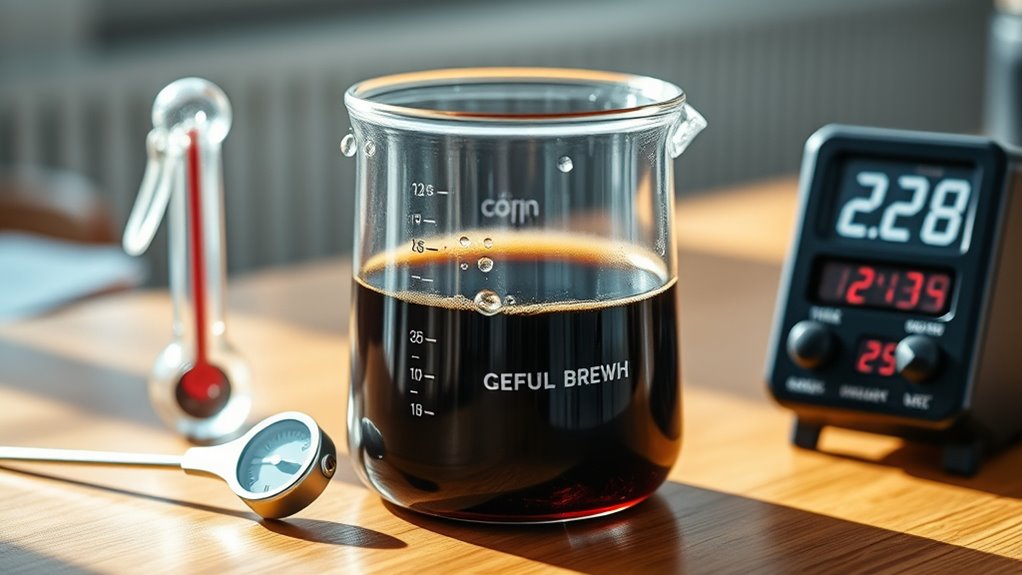
To perfect your cold brew, you need to experiment with both steeping time and temperature. Longer steeping can boost strength, but too much time might introduce bitterness, so find what works best for your taste. Keeping the temperature steady, typically between 35°F and 55°F, helps guarantee consistent extraction and flavor.
Optimal Steeping Duration
Finding the perfect steeping time for cold brew depends on experimenting with different durations and temperatures. Generally, longer steeping extracts more flavors and caffeine, but it can also introduce bitterness if overdone. For a smoother, balanced taste, aim for 12 to 24 hours. Start with 12 hours and taste-test your brew; if it’s too weak, extend the steeping time. If it’s too strong or bitter, reduce it next time. Keep in mind that ambient temperature influences extraction speed—warmer environments may require shorter steeping times. Record your results to identify your ideal duration. Remember, patience is key; rushing the process can compromise flavor, while over-steeping may produce undesirable notes. With practice, you’ll find the ideal steeping duration that suits your preferred flavor profile.
Ideal Temperature Settings
Adjusting the temperature during cold brew steeping can substantially influence the extraction process and final flavor. Cooler temperatures, around 40°F to 50°F, slow extraction, resulting in a smoother, less acidic brew with nuanced flavors. Warmer temperatures, nearing 70°F to 75°F, accelerate extraction, producing a bolder, more robust taste but risking increased bitterness if overstepped. Ideally, you want a balance; around 55°F to 60°F often yields a harmonious flavor profile. Use a refrigerator or a cool, dark spot to maintain consistent temperature. Keep in mind that small adjustments can markedly impact the final product. Experiment with different settings within this range to discover what best suits your taste preferences, ensuring your cold brew is flavorful, balanced, and enjoyable every time.
Troubleshooting Common Cold Brew Issues

Cold brew coffee can sometimes turn out less than perfect, but most issues have straightforward solutions. If your brew is too weak, try increasing the coffee-to-water ratio or extending steeping time. If it’s overly bitter, consider reducing extraction time or using coarser grounds. A cloudy or gritty brew often indicates too fine a grind or over-extraction. To fix this, adjust your grind size or filtration process.
- Use the correct grind size to prevent over-extraction
- Adjust steeping time based on desired strength
- Improve filtration to avoid cloudiness and grit
Frequently Asked Questions
How Does Water Mineral Content Affect Cold Brew Extraction?
You might wonder how water mineral content influences cold brew extraction. Minerals like calcium and magnesium can enhance flavor, making your brew smoother and more balanced. They also help extract certain compounds more effectively, improving overall taste. However, too many minerals may cause cloudiness or undesirable flavors. Using filtered or balanced mineral water guarantees ideal extraction, giving you a richer, well-rounded cold brew experience.
Can Additives or Flavorings Alter Extraction Time and Temperature Effects?
Additives and flavorings can influence cold brew extraction by affecting how quickly flavors dissolve and the overall profile. For instance, adding spices or citrus can introduce compounds that extract at different rates, potentially altering steeping time. Some flavorings might also change the brew’s temperature stability or infusion process, so you might need to adjust your steeping time or temperature to achieve the desired flavor balance.
What Are the Health Implications of Different Cold Brew Brewing Parameters?
While exploring cold brew brewing, you might overlook subtle health effects tied to brewing parameters. Longer extraction times and higher temperatures could gently influence caffeine levels and acidity, impacting your well-being. You’ll want to pay attention to how tweaking these factors might benefit or challenge your health. By mindfully adjusting your process, you can enjoy your coffee while supporting your overall wellness, making every cup a thoughtful choice.
How Do Ambient Environmental Conditions Impact Cold Brew Consistency?
Ambient environmental conditions, like temperature and humidity, considerably affect your cold brew consistency. Warmer temperatures can speed up extraction, making your brew stronger or more bitter, while cooler conditions slow it down, leading to milder flavors. High humidity might introduce unwanted mold or spoilage risks. By controlling your brewing environment or adjusting your process, you guarantee a more consistent, balanced cold brew every time.
Is There a Significant Difference in Caffeine Content at Various Extraction Temperatures?
You might wonder if temperature affects caffeine levels in cold brew. Generally, higher extraction temperatures can increase caffeine solubility, leading to slightly more caffeine in your coffee. However, the difference isn’t huge, and other factors like brew time and grind size matter more. So, while temperature plays a role, it doesn’t drastically change caffeine content, letting you focus on other brewing variables for your perfect cold brew.
Conclusion
Think of cold brew extraction like tuning a guitar—strike the right balance between time and temperature, and you get a smooth, harmonious flavor. I once left my brew too long, and it turned bitter, like a strained string. But when I found the sweet spot, the clarity and richness shone through, much like a perfectly tuned guitar string. By experimenting with these variables, you’ll craft a cold brew that’s just right for your taste.



